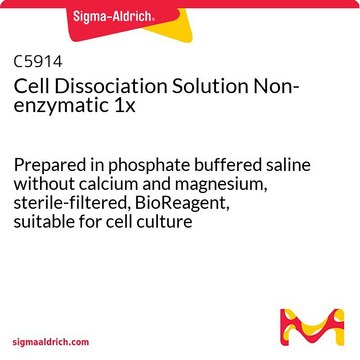SCR005
Accutase cell detachment solution
A cell detachment solution of proteolytic & collagenolytic enzymes. The reagent is useful for creating single cell suspensions from clumped cell cultures for accurate cell counting, detachment of cells from primary tissue.
Synonym(s):
Cell detachment solution
About This Item
Recommended Products
Quality Level
form
liquid
manufacturer/tradename
Chemicon®
input
sample type cardiac stem cell(s)
sample type neural stem cell(s)
sample type pancreatic stem cell(s)
sample type: mouse embryonic stem cell(s)
sample type: human embryonic stem cell(s)
sample type mesenchymal stem cell(s)
sample type hematopoietic stem cell(s)
sample type induced pluripotent stem cell(s)
sample type epithelial cells
shipped in
dry ice
General description
Because the reagent does not contain universally proteolytic enzymes it may not release all cell/tissue types uniformly. Some optimization of cell type and passage number, as well as, incubation time and reagent strength typically needs to be performed to optimize the reagents effectiveness.
ACCUTASE has been shown to be effective on a wide variety of cell types including: fibroblasts, keratinocytes, vascular endothelial cells, hepatocytes, vascular smooth muscle cells, hepatocyte progenitors, primary chick embryo neuronal cells, bone marrow stem cells, adherent CHO and BHK cells, macrophages, 293 cells, L929 cells, immortalized mouse testicular germ cells, 3T3, Vero, COS, HeLa, NT2, MG63, M24 and A375 metastatic melanoma, gliomas U251 and D54, HT1080 fibrosarcoma cells, and Sf9 insect cells.
Each lot of ACCUTASE is tested for Sterility (by USP membrane filtration method), enzymatic activity (tested with synthetic chromagenic tetrapeptides) and cell detachment from tissue culture plastic.
Application
1. Thaw ACCUTASE® at room temperature.
2. Wash plate, flask or beads with sterile PBS.
3. Add ACCUTASE to culture dish or flask using aseptic procedures at 10 ml per 75-cm2 surface area.
4. Return culture to 37°C incubator and allow cells to detach (5-10 minutes).
5. Count cells and passage as usual. No additional washes or enzyme inhibitors are required
Optimal incubation times and reagent strength needs to be determined for each cell/tissue type tested by the enduser.
Physical form
Storage and Stability
Legal Information
Disclaimer
Storage Class Code
12 - Non Combustible Liquids
WGK
WGK 2
Flash Point(F)
Not applicable
Flash Point(C)
Not applicable
Certificates of Analysis (COA)
Search for Certificates of Analysis (COA) by entering the products Lot/Batch Number. Lot and Batch Numbers can be found on a product’s label following the words ‘Lot’ or ‘Batch’.
Already Own This Product?
Find documentation for the products that you have recently purchased in the Document Library.
Articles
Fibroblast growth factors (FGFs) are secreted glycoproteins that regulate several fundamental developmental pathways and help regulate mesoderm and ectoderm patterning in the early embryonic development.
Our team of scientists has experience in all areas of research including Life Science, Material Science, Chemical Synthesis, Chromatography, Analytical and many others.
Contact Technical Service







